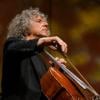
Beethoven, as marketing departments far and wide reminded us, has a 250th birthday in 2020. Being homebound is no reason not to celebrate. Indeed, it may offer an ideal opportunity to do just that, by reconnecting with music we think we know so well we’ve stopped hearing it. My own recent listening has included the Diabelli Variations, the Symphony No. 7, and a disc of absorbing violin sonatas I hadn’t touched in years.
 Sony Classical is staging a kind of parallel party, with their Beethoven’s World CDs, featuring music of the master’s contemporaries. A previous release showcased violin concertos by Franz Joseph Clement. Now from Beethoven’s World comes a pair of double cello concertos, by Antonin Reicha and Bernhard Romberg. A trio of jolly dances by Josef von Eybler rounds out the bill. The recording will be released in the U.S. on April 24.
Sony Classical is staging a kind of parallel party, with their Beethoven’s World CDs, featuring music of the master’s contemporaries. A previous release showcased violin concertos by Franz Joseph Clement. Now from Beethoven’s World comes a pair of double cello concertos, by Antonin Reicha and Bernhard Romberg. A trio of jolly dances by Josef von Eybler rounds out the bill. The recording will be released in the U.S. on April 24.
Born the same year as Beethoven (the two were later philosophy classmates in Vienna and members of the same orchestra), Reicha was not only a prolific and well-regarded composer but a prominent and forward-looking music theorist as well. His intelligence and powers of invention are on full display in the 1805 Sinfonia Concertante for Two Cellos and Orchestra.
The longest and most substantial work on this recording, it opens with a nearly 22-minute Allegro brimming over with richly developed material oscillating between E major and E minor. A forceful, stormy orchestral opening gives way to an equally striking duo passage for the soloists alone.

Bruno Delepelaire and Stephan Koncz stride into action with tones by turn pithy and delicate. The instrumental lines wander in transverse motion, then snap into imitation. Nimble sprints from high to low turn gently caressing over a flute ostinato. The key changes and mood changes keep coming.
The soloists defer to each other in arpeggiated accompaniments only to reassert themselves with some fresh gambit. It’s an ongoing exchange at once dramatic and demure Reinhard Goebel leads the German Radio Philharmonic Orchestra with a keen ear for this wonderful movement’s eventful, propulsive design. A quiet landing confirms what a soaring flight this has been.
A sweet-tempered Largo sends the cellists into the higher registers, which they handle with a singing legato. The closing movement takes off with a mock-military thudding that deftly segues into a lilting folk melody, backed later on by the braying of hunters’ horns. Even as he’s pouring on the rustic charm, Reicha once again displays his flair for keen, surprising development of his themes. There may not be genius here, but the Sinfonia Concertante reminds us of the rich musical soil Beethoven shared with others.
Romberg’s Concertino for Two Cellos and Orchestra is a shorter and decidedly less ambitious piece. Played without pause, its three movements include some colorful orchestral writing in the first, a fetching echo effect in the second, and some playful tunesmithing in the third. The performers don’t try to oversell the material, taking a bright, breezy approach throughout.
Slighter still are the dances in von Eybler’s Divertimento for Shrove Tuesday. A trumpet call sends the opening March off and going. Sleighbells and yawping strings sparkle through the cloggy Contradance. And then, as if matters have suddenly gown serious, the closing Allemande opens gravely, only to cheer up with a perpetual motion middle section than finally wears itself out and fades away.
Reicha earns the big props here, but von Eybler gets a grin for these frothy dances.




